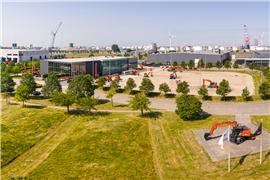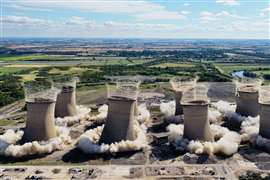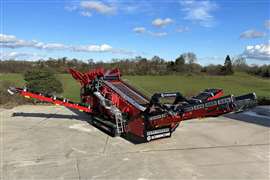World Demolition Awards Shortlist - Explosive Demolition Award
03 September 2025
D&Ri is pleased to announce the Explosive Demolition Award category shortlist for the 2025 World Demolition Awards, which will take place on 5 November in Nashville, US, as part of the World Demolition Summit.
Congratulations to the following companies who made the Explosive Demolition Award shortlist.
Explosive Demolition Award
Brown and Mason
COUNTRY: UK
PROJECT: Cottam Power Station Chimney
CLIENT: EDF Energy
STATEMENT:
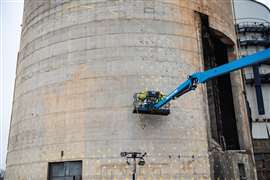 Photo: Brown & Mason
Photo: Brown & Mason
In a landmark moment for the demolition industry, the 200m chimney at EDF’s decommissioned Cottam Power Station in Nottinghamshire was brought down with unprecedented precision using a pioneering explosive method.
Situated among live infrastructure, including a gas main, absorbers, and electricity substation, and in close proximity to residential properties, the complex operation required a meticulous level of control.
Rather than toppling the chimney in traditional fashion, the team employed a “telescoping” collapse technique, causing the structure to implode vertically.
The result: vibrations reduced by 75%, debris confined to a 35m radius, and zero damage to surrounding assets. A Comparative Risk Assessment found this method safer than alternative approaches, including piecemeal demolition, by removing the need for prolonged work at height.
The operation included drilling over 11,000 precisely placed charge holes, with the blowdown executed flawlessly on 20th March 2025.
Meticulous planning was matched with exemplary safety and stakeholder management. A dedicated Blowdown Committee, transparent public engagement, and experienced SHEQ leadership ensured total control throughout.
Even misinformation from AI-generated fake news was countered through proactive community engagement.
This project does not just mark a technical achievement, it shifts the narrative around explosive demolition. It proves that, in the right hands, it is not only viable but often the safest, cleanest, and most efficient option for high-risk structures.
Cottam’s demolition sets a new benchmark for explosive demolition across the industry, standing as a model of control and confidence.
Controlled Demolition Inc
COUNTRY: US
PROJECT: Tropicana Las Vegas Hotel - Paradise Tower and Club Tower
CLIENT: GGG Demolition
STATEMENT:
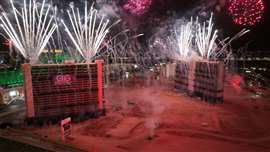 Photo: Controlled Demolition Inc
Photo: Controlled Demolition Inc
Controlled Demolition, Inc. (CDI) of Phoenix, Maryland, USA, acting as the Explosive Sub-Contractor to GGG Demolition, Inc., performed the design of and successful implosion of the two, 23-story Tropicana Hotel and Casino towers: the structural steel framed Paradise Tower and the reinforced concrete Club Tower in Las Vegas, Nevada.
CDI loaded over 1,421 lbs of dynamite into 1,123 holes drilled into columns/shear walls of the Club Tower and 1,451 LF of linear shaped charges at 219 cut-points in the Paradise Tower.
A 6 minute 20 second fireworks/drone show sent the Tropicana out in style and the two towers were successfully imploded at 2:37 am on October 9, 2024.
Vibration monitoring was conducted at numerous locations. Peak particle velocity and air overpressure readings were a fraction of limits allowed by local, State and federal regulations. CDI coordinated with the Clark County Police, Fire & Public Works Departments, electric, gas and water utility companies, the Harry Reid International Airport, privately owned helicopter tour companies and numerous media outlets.
CDI also met extensively with adjacent property owners of casinos, hotels and condominiums on how to mitigate the impact of the implosion and street closures on their property. This marked the 33rd and 34th structure imploded by CDI in Las Vegas/Clark County, Nevada.
From the structural complexity of the two towers, to the extensive coordination and timing required for the pyrotechnic show and planning with Clark County, this was one of the most complex projects CDI has ever undertaken.
PDC Explosives Engineering
COUNTRY: England
PROJECT: Sizewell A - Turbine Blocks
CLIENT: Erith Group
STATEMENT:
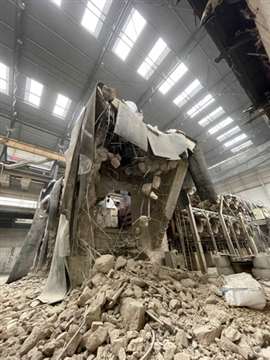 Photo: PDC Explosives Engineering
Photo: PDC Explosives Engineering
The decommissioning of the Sizewell “A” (SZW A) nuclear power station in Suffolk, UK, involved demolishing the redundant turbine hall and removing its massive reinforced concrete turbine bases.
These structures, measuring 92m by 19.8m by 10.4m, once supported essential turbine hall components but needed to be removed to clear the land and advance the site’s decommissioning. Due to the proximity of the operational Sizewell “B” (SZW B) reactor, the project had to comply with strict nuclear regulations and minimise disruption.
To accelerate the process, PDC Explosives Engineering implemented an innovative pre-weakening technique using controlled explosives, reducing the mechanical demolition timeframe from six months to two months and significantly limiting noise, vibration, and disturbance to workers and the local community.
The method used the most significant single deployment of electronic detonators and NG cartridge explosives on an operational UK-licensed nuclear site, with extensive test blasts to optimise charge weights and ensure containment.
The work adhered to Relevant Good Practice (RGP) under CDM 2015, BS 5607, and BS 6187 standards, ensuring that risks were minimised as far as reasonably practicable.
Close collaboration with SZW B site management, the Civil Nuclear Constabulary, local authorities, and community liaison groups ensured safe and efficient execution.
Completed on November 1, 2024, the demolition enabled the rapid processing of 4,980 tons of concrete, resulting in a 4-month program reduction and a carbon savings of 78.4 tons.
This success sets a precedent for future UK nuclear decommissioning, supporting climate goals through faster demolition, lower emissions, and improved recycling.
DemMaster and Safedem
COUNTRY: Scotland
PROJECT: Caledonia Road, Glasgow
CLIENT: New Gorbals Housing Association
STATEMENT:
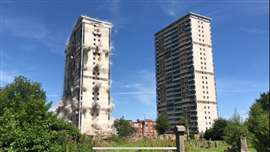 Photo: Safedem
Photo: Safedem
“An absolute master class” was how the explosive demolition of Caledonia Road tower blocks was described.
Detailed planning and co-ordination by Dem-Master and Safedem Ltd laid the foundations for a sector leading result.
The two 24 story tower blocks collapsed exactly as predicted into an extremely confined site, but most importantly safely away from a nursery / child care facility just 9 metres away and a high pressure gas main just 5 metres away.
Thorough structural analysis and modelling by ASI accuratley predicted the demolition collapse mechanism and supported the design of exceptional proteciton levels installed by Dem-Master.
A complex explosive delay sequence designed by Safedem comprising over 2200 individual charges initiated by non-electric delay detonators controlled the rate and direction of the structures though collapse down to site level.
Post blowdown inspections confirmed zero damage to the nearby nursery or high pressure gas main.
The Housing Association Director described it as “a brilliant job !”
Trifecta
COUNTRY: US
PROJECT: Avon Lake Power Plant
CLIENT: ALERG
STATEMENT:
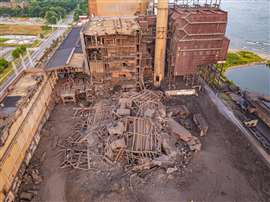 Photo: Trifecta
Photo: Trifecta
Trifecta Services Company, in partnership with Dykon Demolition and Sauls Seismic, completed one of the largest explosive demolition events in history at the Avon Lake Power Plant in Ohio.
The project involved two major implosions carried out between 2022 and 2024 within a 40-acre site bordered by homes, businesses, and critical infrastructure.
With extensive planning and community collaboration, Trifecta brought down four boiler units, two 600-foot stacks, and one heavily reinforced precipitator.
The project’s first implosion in July 2024 safely felled Boiler Units 9 and 10. Precipitator 8 was postponed due to fall trajectory concerns and handled in the second phase alongside Boiler Units 11 and 12 and Stacks 8 and 9.
Public concern over air quality nearly delayed the second blast, but ALERG, the property owner, helped maintain momentum through transparent communication and additional environmental modeling.
To cut through six-inch flanges on Precipitator 8, Trifecta and Dykon sourced 5,000-grain shape charges from overseas and custom-assembled them with C-4.
Advanced safety monitoring was deployed across both blasts, including seismic sensors, air quality sampling, and real-time dust suppression. Both implosions were executed without injury, incident, or disruption.
Over 83,000 tons of ferrous material and 4 million pounds of non-ferrous material were recycled. The cleared site is being transformed into shoreline greenspace and public-use areas, with the redevelopment plan earning a 2025 AIA Urban Design Award.
Trifecta is proud to have safely delivered a project that honors both technical excellence and community impact.
CONNECT WITH THE TEAM







